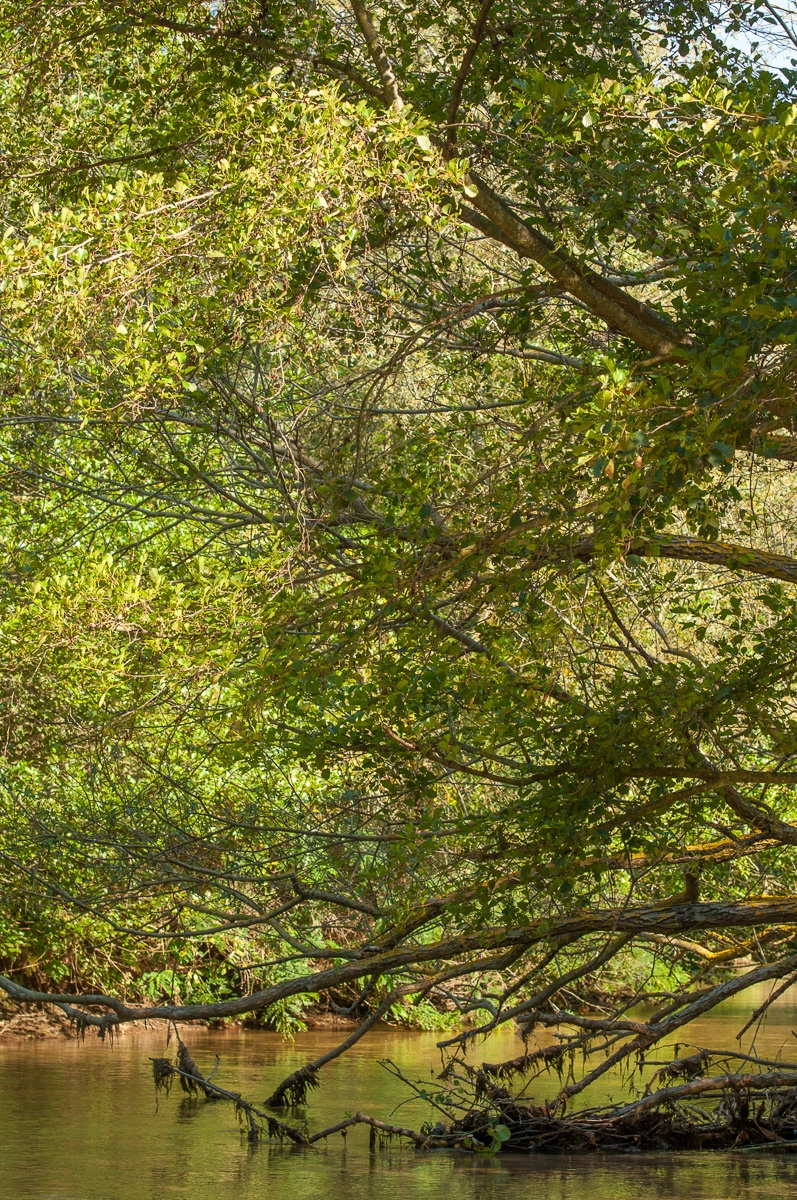
Northeast of Chrisoupoli there is an area characterized by a moderate 20 smaller wetlands. Of these, seven are considered major lakes and ponds. It covers a total area of about 20 sq.km. This area connects ecologically and geographically the Nestos Delta, the riparian forest and the nearby northern mountainous region. This is reflected in the wide range of habitats and diversity of animal and plant species. This uniqueness in the Nestos Delta in conjunction with the second important factor, the agriculture and animal husbandry, brought to the region, created an ecologically valuable area. Due to the data of natural conditions and under the influence of agriculture and grazing a rich mosaic was created that compose wild areas with grass, scrub, scrub forest vegetation, orchards, olive groves, other crops, reeds, magazines floodplains and permanent water surfaces. The stagnant freshwater surrounded with reeds and marshy areas give the area great ecological value, which is maximized due to neighboring to a variety of dryland (karst formations, dry meadows, prinones, pasture, etc.). As already noted, a major factor that shapes the region is the agriculture. Due to the rather mild land use it contributed decisively to the diversity of habitats and species. So here the visitor is not just approaching nature but is simply displayed in a rural landscape of great ecological value, which betrays the harmonious coexistence of nature and man. The fact that within a single research were found over 400 species of plants, confirms the rich flora of the region of Lakes of Chrisoupoli. The lakes with reed beds are partially covered with spectacular carpets of lilies (Nymphea alba), 15 orchid species recorded in the area. This number corresponds to 43% of species in the region. For example Limodorum abortivum and hybrids Orchis morio x papilionacea and Serapias vomeracea ssp. longipetala x bergonii. The combination of trees and shrubs in the area seems to have high positions in this massif, characteristic of which are the Yew, the Palioyri the Gortsia, anchovy and downy oak (Quercus pubescens) etc. While anyone can see the riparian forest, willows, poplars, etc. 13 species of freshwater fish are shown in the waters of the lakes. The presence of species such as Leucaspius delineatus, Rhodeus sericeus amarus and Cobitis stroumicae even proves good water quality in the region and suggests ecologically unpolluted waters. Like the fauna of amphibians, the bulk of reptile fauna of the total area is endemic in the Lake District of Chrisoupoli, or mainly at ease. 8 species of amphibians and 12 species of reptiles were observed in the Alatzagkiolas. During the period 1981 to 1995 there has been recorded in lakes of Chrisoupoli a total of 211 species of birds. From the breeding species Bittern (Ixobrychus minutus), the Purple (Ardea purpurea), the Petrotrilida (Burhinus oedicnemus), quail (Coturnix coturnix), the Marsh Harrier (Circus aeruginosus) stand out the Roller (Coracias garrulus), while the region is an important feeding area for storks. In winter a few dozen Pygmy Cormorants (Phalacrocorax pygmeus) are gather here to find food and have been observed to hunt on a regular basis the Golden eagle (Aquila chrysaetos), the Goshawk (Accipiter gentilis), the Peregrine Falcon (Falco peregrinus), and vultures (Gyps fulvus). Examples of mammalian fauna that find suitable habitat here is the Jackal, the badger, the fox, the weasel, marten etc.
 Northeast of Chrisoupoli there is an area characterized by a moderate 20 smaller wetlands. Of these, seven are considered major lakes and ponds. It covers a total area of about 20 sq.km. This area connects ecologically and geographically the Nestos Delta, the riparian forest and the nearby northern mountainous region. This is reflected in the wide range of habitats and diversity of animal and plant species. This uniqueness in the Nestos Delta in conjunction with the second important factor, the agriculture and animal husbandry, brought to the region, created an ecologically valuable area. Due to the data of natural conditions and under the influence of agriculture and grazing a rich mosaic was created that compose wild areas with grass, scrub, scrub forest vegetation, orchards, olive groves, other crops, reeds, magazines floodplains and permanent water surfaces. The stagnant freshwater surrounded with reeds and marshy areas give the area great ecological value, which is maximized due to neighboring to a variety of dryland (karst formations, dry meadows, prinones, pasture, etc.). As already noted, a major factor that shapes the region is the agriculture. Due to the rather mild land use it contributed decisively to the diversity of habitats and species. So here the visitor is not just approaching nature but is simply displayed in a rural landscape of great ecological value, which betrays the harmonious coexistence of nature and man. The fact that within a single research were found over 400 species of plants, confirms the rich flora of the region of Lakes of Chrisoupoli. The lakes with reed beds are partially covered with spectacular carpets of lilies (Nymphea alba), 15 orchid species recorded in the area. This number corresponds to 43% of species in the region. For example Limodorum abortivum and hybrids Orchis morio x papilionacea and Serapias vomeracea ssp. longipetala x bergonii. The combination of trees and shrubs in the area seems to have high positions in this massif, characteristic of which are the Yew, the Palioyri the Gortsia, anchovy and downy oak (Quercus pubescens) etc. While anyone can see the riparian forest, willows, poplars, etc. 13 species of freshwater fish are shown in the waters of the lakes. The presence of species such as Leucaspius delineatus, Rhodeus sericeus amarus and Cobitis stroumicae even proves good water quality in the region and suggests ecologically unpolluted waters. Like the fauna of amphibians, the bulk of reptile fauna of the total area is endemic in the Lake District of Chrisoupoli, or mainly at ease. 8 species of amphibians and 12 species of reptiles were observed in the Alatzagkiolas. During the period 1981 to 1995 there has been recorded in lakes of Chrisoupoli a total of 211 species of birds. From the breeding species Bittern (Ixobrychus minutus), the Purple (Ardea purpurea), the Petrotrilida (Burhinus oedicnemus), quail (Coturnix coturnix), the Marsh Harrier (Circus aeruginosus) stand out the Roller (Coracias garrulus), while the region is an important feeding area for storks. In winter a few dozen Pygmy Cormorants (Phalacrocorax pygmeus) are gather here to find food and have been observed to hunt on a regular basis the Golden eagle (Aquila chrysaetos), the Goshawk (Accipiter gentilis), the Peregrine Falcon (Falco peregrinus), and vultures (Gyps fulvus). Examples of mammalian fauna that find suitable habitat here is the Jackal, the badger, the fox, the weasel, marten etc.
Northeast of Chrisoupoli there is an area characterized by a moderate 20 smaller wetlands. Of these, seven are considered major lakes and ponds. It covers a total area of about 20 sq.km. This area connects ecologically and geographically the Nestos Delta, the riparian forest and the nearby northern mountainous region. This is reflected in the wide range of habitats and diversity of animal and plant species. This uniqueness in the Nestos Delta in conjunction with the second important factor, the agriculture and animal husbandry, brought to the region, created an ecologically valuable area. Due to the data of natural conditions and under the influence of agriculture and grazing a rich mosaic was created that compose wild areas with grass, scrub, scrub forest vegetation, orchards, olive groves, other crops, reeds, magazines floodplains and permanent water surfaces. The stagnant freshwater surrounded with reeds and marshy areas give the area great ecological value, which is maximized due to neighboring to a variety of dryland (karst formations, dry meadows, prinones, pasture, etc.). As already noted, a major factor that shapes the region is the agriculture. Due to the rather mild land use it contributed decisively to the diversity of habitats and species. So here the visitor is not just approaching nature but is simply displayed in a rural landscape of great ecological value, which betrays the harmonious coexistence of nature and man. The fact that within a single research were found over 400 species of plants, confirms the rich flora of the region of Lakes of Chrisoupoli. The lakes with reed beds are partially covered with spectacular carpets of lilies (Nymphea alba), 15 orchid species recorded in the area. This number corresponds to 43% of species in the region. For example Limodorum abortivum and hybrids Orchis morio x papilionacea and Serapias vomeracea ssp. longipetala x bergonii. The combination of trees and shrubs in the area seems to have high positions in this massif, characteristic of which are the Yew, the Palioyri the Gortsia, anchovy and downy oak (Quercus pubescens) etc. While anyone can see the riparian forest, willows, poplars, etc. 13 species of freshwater fish are shown in the waters of the lakes. The presence of species such as Leucaspius delineatus, Rhodeus sericeus amarus and Cobitis stroumicae even proves good water quality in the region and suggests ecologically unpolluted waters. Like the fauna of amphibians, the bulk of reptile fauna of the total area is endemic in the Lake District of Chrisoupoli, or mainly at ease. 8 species of amphibians and 12 species of reptiles were observed in the Alatzagkiolas. During the period 1981 to 1995 there has been recorded in lakes of Chrisoupoli a total of 211 species of birds. From the breeding species Bittern (Ixobrychus minutus), the Purple (Ardea purpurea), the Petrotrilida (Burhinus oedicnemus), quail (Coturnix coturnix), the Marsh Harrier (Circus aeruginosus) stand out the Roller (Coracias garrulus), while the region is an important feeding area for storks. In winter a few dozen Pygmy Cormorants (Phalacrocorax pygmeus) are gather here to find food and have been observed to hunt on a regular basis the Golden eagle (Aquila chrysaetos), the Goshawk (Accipiter gentilis), the Peregrine Falcon (Falco peregrinus), and vultures (Gyps fulvus). Examples of mammalian fauna that find suitable habitat here is the Jackal, the badger, the fox, the weasel, marten etc.





